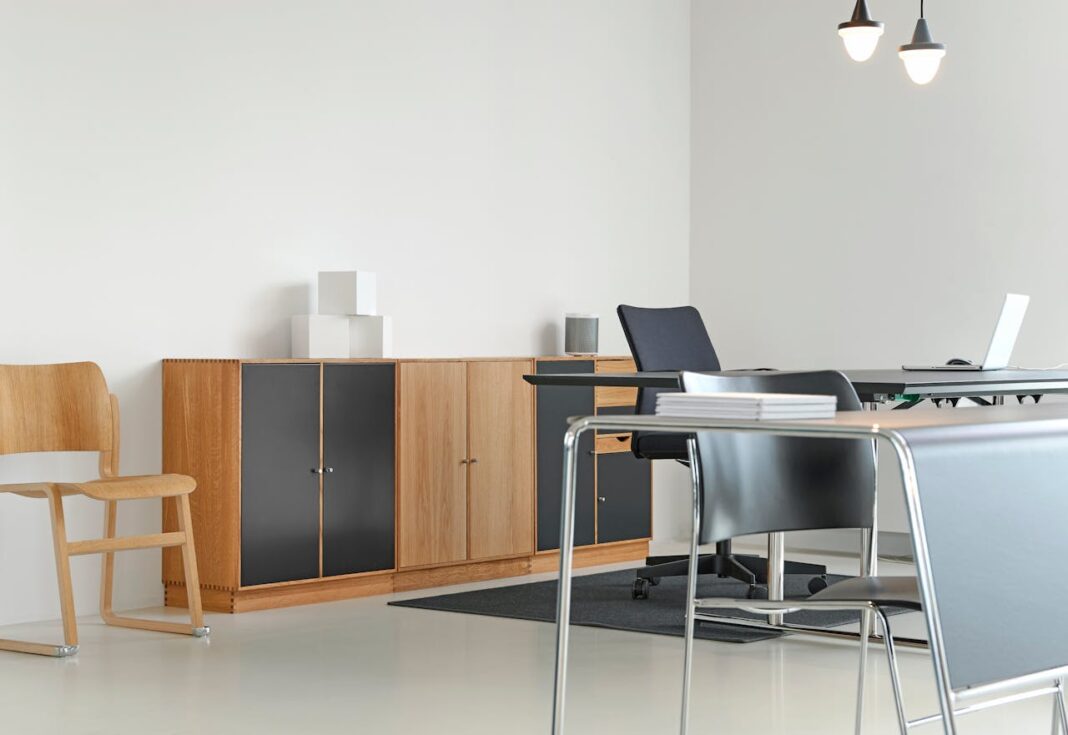As we navigate through the challenges and opportunities presented by the 21st century, UK businesses are at a crossroads in terms of how they conceptualise and implement office design. With a keen eye on the future, companies across the nation are reimagining their workspaces to align with evolving environmental concerns, technological advancements, and the well-being of their workforce. This shift is not merely about aesthetics or making a statement; it’s a strategic pivot towards creating spaces that foster innovation, productivity, and sustainability. This article delves into the transformative journey of office design in the UK, exploring the pivotal themes of sustainability, technology, and well-being that are setting new standards for success in the business landscape.
The Shift Towards Sustainability in Workspace Design
The conversation around sustainable office design has moved from the fringes to the forefront of business planning in the UK. With the built environment responsible for a significant portion of the country’s carbon emissions, the urgency for green, energy-efficient workspaces is more pressing than ever. The UK Green Building Council underscores this, highlighting that 25% of the UK’s total carbon emissions emanate from the built environment. This statistic is a clarion call for businesses to embrace sustainable design principles that not only reduce environmental impact but also create healthier and more productive working environments.
Benjamin Lesser, head of design and innovation at Derwent London, encapsulates the sentiment driving this change: “It would be a disaster to hollow out our cities. The sanest position will be to have high-quality, highly sustainable buildings that make it desirable for people to come into the city.” Lesser’s perspective sheds light on the dual benefit of sustainable office design: mitigating environmental damage while rejuvenating urban centres as hubs of innovation and collaboration.
Innovating Spaces for Enhanced Productivity
The transformation of office spaces across the UK is not just about sustainability; it’s equally focused on enhancing productivity through innovative design. A recent shift in work dynamics, prompted by evolving business needs and employee preferences, has seen 63% of UK business leaders rethinking their office layouts. This reconsideration towards office space is largely driven by a desire to foster more collaborative and shared environments. The move towards creating spaces that facilitate teamwork, creativity, and flexibility reflects a deeper understanding of the link between well-designed workspaces and improved employee performance.
The drive towards more productive office environments aligns with a broader recognition that the nature of work itself is changing. As businesses adapt to this new reality, the design of office spaces has become a key factor in attracting and retaining talent, encouraging innovation, and ultimately, securing a competitive edge in the marketplace. This evolution points to a future where office design is intrinsically linked to a company’s strategic objectives, with spaces tailored to support the specific needs and workflows of their teams.
The Rise of Office Pods: A Solution for Flexibility and Privacy
In the quest for more dynamic and flexible office designs, the emergence of office pods stands out as a noteworthy trend. These modular units offer a blend of privacy and openness, catering to the diverse needs of today’s workforce. Whether it’s for focused solo work, collaborative projects, or confidential meetings, office pods are proving to be a versatile solution that can be seamlessly integrated into existing office layouts. This adaptability makes them an ideal choice for businesses looking to modernise their workspaces without committing to extensive renovations.
Moreover, the introduction of office pods into the workplace is a testament to the changing perceptions of what an office should be. It’s no longer just a place to work; it’s a space that must support the multifaceted demands of modern business activities. Companies like Furnify are at the forefront of this trend, offering a range of modern office furniture that includes office pods, work pods, and meeting pods. These innovations are not just about creating functional spaces; they’re about redefining the office environment to reflect the evolving priorities of flexibility, privacy, and employee wellbeing.
This approach to office design reflects a broader shift towards workspaces that can adapt to the changing needs of businesses and their employees. As we move forward, the importance of flexible and responsive design elements like office pods is set to grow, reshaping our expectations of what an office can and should offer.
Balancing Space and Functionality in Modern Office Furniture
The evolution of office design also extends to the furniture that populates these spaces. Modern office furniture is increasingly being designed to strike a balance between space efficiency and functionality. This trend is driven by the recognition that a well-designed piece of furniture can significantly impact productivity, comfort, and even the overall aesthetic appeal of the office. Ergonomics plays a central role in this new wave of office furniture, with chairs, desks, and storage solutions being crafted to support the physical well-being of users while maximising the use of available space.
In this context, the choice of office furniture becomes a strategic decision. Businesses are looking for pieces that not only fit the visual identity of their brand but also contribute to the creation of an environment that encourages creativity and efficiency. The emphasis is on selecting items that are versatile, durable, and sustainable, reflecting the broader themes of adaptability and environmental responsibility that define the future of office design in the UK.
The Impact of Technology on Office Design
The intertwining of technology and office design is reshaping the fabric of workspaces in profound ways. As businesses navigate the complexities of the modern work environment, the integration of technological advancements into the office landscape is becoming increasingly central. This shift is not just about adopting new tools; it’s about reimagining how office spaces can enhance collaboration, communication, and overall productivity in the digital age.
A quote from The Medium encapsulates the essence of this transformation: “One of the primary ways technology influences office layout is through facilitating seamless collaboration and communication. Modern offices are adopting open-plan layouts with integrated technological solutions like video conferencing systems, instant messaging applications, and shared digital platforms.” This observation highlights the role of technology as both a facilitator and a driver of change in office design. By embedding these technological solutions into the very structure of office spaces, businesses are creating environments that are more connected, flexible, and conducive to the dynamic nature of modern work.
The incorporation of technology into office design goes beyond just functional improvements. It signifies a shift towards creating smarter, more intuitive work environments. These spaces are designed to adapt to the needs of their users, with automated systems for lighting, climate control, and even furniture adjustments contributing to a more comfortable and efficient workplace. As we look to the future, the relationship between technology and office design is set to deepen, with innovations in digital infrastructure and smart office solutions continuing to redefine what it means to work in a modern office.
Designing for Wellbeing: Beyond the Physical Space
The concept of office design has expanded beyond the physical layout and furnishings to encompass the overall well-being of employees. Today’s office spaces are being thought of as extensions of the home, places where comfort, community, and a sense of belonging are paramount. Yaron Rosenblum, writing for Workplace Insight, captures this shift succinctly: “Today’s office space is more than just a ‘place of work’. It needs to feel like an extension of the home, incorporating inviting spaces designed with comfort and social interaction in mind.”
This emphasis on well-being is manifesting in the inclusion of break areas, relaxation spaces, and even wellness centres within office designs. These features are not mere luxuries; they are fundamental components of a workplace that prioritises the mental and physical health of its employees. By creating environments that people enjoy being in, businesses are not only enhancing the quality of work but are also fostering a culture of wellness and care.
Conclusion: Embracing Change for a Sustainable and Successful Future
The journey of office design in the UK is emblematic of a broader transformation within the business landscape, where sustainability, technology, and well-being are converging to redefine what a workplace can and should be. This evolution is not merely a response to changing aesthetic preferences or the latest trends; it’s a strategic reimagining of office spaces as catalysts for innovation, productivity, and environmental stewardship.
The drive towards more sustainable office designs reflects a deepening understanding of the role businesses play in tackling climate change and promoting a healthier planet. By prioritising energy efficiency, sustainable materials, and green building practices, UK businesses are setting new standards for what it means to be a responsible corporate citizen in the 21st century.
Simultaneously, the integration of technology into office spaces is facilitating a shift towards more collaborative, flexible, and efficient work environments. As digital tools become increasingly embedded in the fabric of our work lives, the design of office spaces must evolve to support these new ways of working, ensuring that technology serves to enhance, rather than impede, productivity and well-being.
Moreover, the emphasis on designing for well-being underscores a growing recognition of the importance of mental and physical health in the workplace. By creating spaces that are not only functional but also nurturing and inclusive, businesses can support their employees in achieving a better work-life balance, ultimately driving greater satisfaction and success.
As we look to the future, it’s clear that the office design landscape in the UK is poised for continued innovation and transformation. The challenges and opportunities presented by sustainability, technology, and well-being are reshaping our understanding of what an office is and what it can achieve. By embracing change and prioritising these key themes, UK businesses can create work environments that not only meet the demands of today but are also prepared for the uncertainties of tomorrow.






